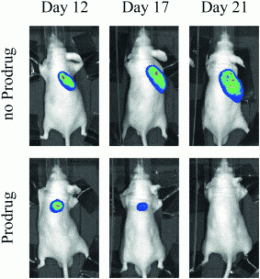Selective tumor treatment: β-galactosidase releases active agent from prodrugs

(Phys.org)—One of the largest challenges of chemotherapy lies in the fact that cancer cells must be killed while healthy tissue must be protected. French researchers have now introduced a new approach in the journal Angewandte Chemie: The enzyme β-galactosidase releases the active drug from an inactive precursor, known as a prodrug, which can only be taken up by tumor cells.
A number of tumor-specific markers have been found over the years. These are receptors that are commonly found in the cell membranes of tumor cells but are absent from or rare on the surfaces of healthy cells. Previously, researchers have mostly used antibodies directed toward these receptors to deliver drugs selectively to tumor cells. The disadvantages of this method are not only the high cost and difficult development and production, but also the inherent risk of undesired immune responses.
A team led by Sébastien Papot at the University of Poitiers has now developed a simpler approach that works without antibodies. It is based on a prodrug with four components: the actual cytotoxic agent, a ligand that recognizes one of the tumor-specific receptors, a "trigger" for the release, and a linker that holds everything together.
In the first step, the ligand binds to the tumor-specific receptor on the surface of a tumor cell. The tumor cell then folds its membrane in to enclose the receptor and prodrug in a bubble and bring them into the cell (receptor-mediated endocytosis). This bubble then fuses with lysosomes, cell organelles whose contents include the enzyme β-galactosidase. This enzyme splits galactose off of polysaccharides. The trigger portion of the prodrug is a galactose unit. As soon as the enzyme splits it off, the linker undergoes a spontaneous decomposition that releases and activates the drug. The drug kills the tumor cell by inhibiting cell division.
In addition, the drug also escapes the actual tumor cell and is absorbed by immediate neighbors—even if they do not have the tumor-specific receptor on their membrane—killing them as well. This is useful because tumors are often made of different types of cells that may not all have the right receptor. More distant, healthy cells are not affected. They are also not able to take up the prodrug because they do not have the special receptors.
Initial animal trials with a prodrug based on this principle showed it to be very effective. The tumors shrank when treated with the prodrug, whereas administration of the free cytostatic was not very effective.
More information: Sébastien Papot, "The First Generation of β-Galactosidase-Responsive Prodrugs Designed for the Selective Treatment of Solid Tumors in Prodrug Monotherapy." Angewandte Chemie International Edition, dx.doi.org/10.1002/anie.201204935
Journal information: Angewandte Chemie , Angewandte Chemie International Edition
Provided by Wiley














